Detailed explanation of planting techniques of Toona sinensis
Toona sinensis belongs to woody vegetables and its tender leaves are edible. When the ten-day average temperature is 15 ℃, the buds begin to sprout and show new leaves. Therefore, the picking period of open-field Toona sinensis in the middle of our province is mid-April. The greenhouse production of Toona sinensis is to transfer the stems of the deciduous 1-2-year-old Toona sinensis into the greenhouse, give it certain temperature and moisture to sprout in the case of highly dense planting, and then pick the young leaves one after another. Here are the specific methods of planting Toona sinensis with you!
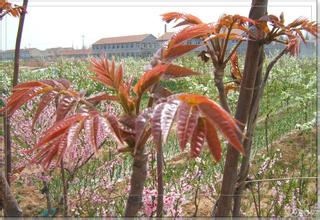
Planting techniques of Toona sinensis
Preparation of ① seeds:
There are many varieties of Toona sinensis, which are often eaten by people, such as red oil Toona sinensis, purple oil Toona sinensis and green Toona sinensis, among which the seeds of purple oil Toona sinensis are large and full and the germination rate is high, so it is the best variety to produce seed Toona sinensis. The seeds of Toona sinensis are triangular, semicircular or rhomboid, reddish brown, with long membranous wings at one end. The weight of a thousand grains is 10-11 grams. The germination rate of Toona sinensis seeds has a great relationship with the age of Toona sinensis. The vitality of Toona sinensis seeds more than 30 years old is very weak, the germination rate is only 5%-10%, and the survival rate is even lower. 10-25-year-old Toona sinensis seeds are suitable for sprout production. The storage life of Toona sinensis seeds is relatively short, and the germination rate begins to decrease in the second half of the year at room temperature, and all of them are lost in one year, so when producing seed Toona sinensis, the seed consumption should be purchased at one time according to the production capacity and one's own needs. In order to maintain a high germination rate, sufficient seeds should be stored in a cold storage or cool and ventilated place of 4Mel 5 ℃ in order to ensure the use of seeds for the four seasons. The membranous long wing of Toona sinensis seed is an important part of seed life maintenance, which can not be removed during storage, otherwise it will affect the germination rate. Therefore, in the production of Toona sinensis sprouts, it is appropriate to choose new seeds that have not been over the summer, and do not use old seeds every other year. The seeds of Toona sinensis should be cleaned before soaking, gently rub the seeds in the pocket, then blow or fan to remove the membranous long wings, screen the fruit stalks and shells, and pick out all kinds of impurities mixed in the seeds. Calculate the amount of seeds to be used according to the requirements of production. After cleaning, wash the seeds for 3 times and then soak the seeds. The water temperature is 20 ℃ and the amount of water is 3 times of the seed volume. The optimum soaking time for Toona sinensis seed germination is 24 hours, and its relative water absorption is 120.2%. During seed soaking, it is best to change the water and wash away the mucus from the seed coat so as to improve the germination speed. After soaking the seeds, remove the seeds and drain the excess water to wait for sowing.
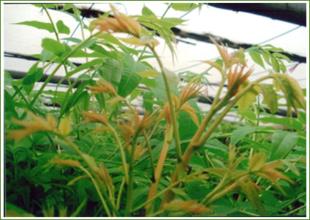
② sowing and sprouting:
Sowing and sprouting are the key links to reduce rotten seeds, improve seedling uniformity and ensure product quality in sprout cultivation. Sowing should be uniform and the sowing amount per plate should be consistent. Because the seeds of Toona sinensis germinated slowly, the germination should be divided into two stages, so the sowing was also scored twice. The sowing amount of the first stage was 750-1000 grams per plate, the germination temperature was 20 ℃ and 23 min, and the germination time was 4 days. The method, method and management of sprouting are similar to those of pea seedlings. After the bud is white and the bud grows 1-2mm, the second sowing and stacking plate will be carried out in time, that is to enter the second stage of budding. Be careful that the seed buds are not too long, otherwise they are easy to be hurt when sowing for the second time. The seeds can be washed with clean water before sowing to reduce mildew during the second stage of budding. The method and management of sprouting in the second stage is similar to that of pea seedlings, during this period, the temperature is 20 ℃ 23 min, the sprouting time is 5 mi 6 days, and the sowing rate of each plate is 40-50 grams. The sprouts of Toona sinensis were put on the cultivation rack for production management when the buds of Toona sinensis were 0.5ml / 1.0m long.
The substrate used in the production of Toona sinensis buds can be clean perlite or white cotton cloth or newsprint directly. For example, using perlite as the substrate, wash the seedling plate first and then spread a layer of newsprint, evenly sow the seeds of Toona sinensis, and then spread a layer of perlite about 3 meters thick. Using perlite as substrate for the production of Toona sinensis buds, what is needed in management is to reduce the amount of water.
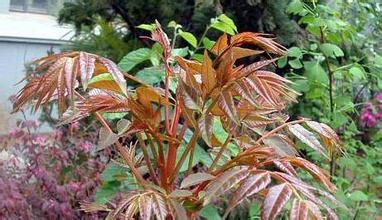
Planting and management technology of Toona sinensis in greenhouse
First, it is necessary to choose the stout stem and full terminal bud of Toona sinensis for regional planting.
If the stem of Toona sinensis is thick, the bud is large and full, and the nutrients are sufficient, the yield of new leaves is high. Therefore, seedlings of Toona sinensis in greenhouse should be selected before planting. When the heavy frost comes, the leaves of Toona sinensis fall off naturally, and the nutrients are returned to the stem and dug out and graded. The height of one-year-old seedlings is 0.6 meters, the stem diameter is more than 1 meter, and the height of two-year-old seedlings is 1-1.5 meters, and the stem diameter is more than 1.5 meters. After raising the seedlings, the seedlings were graded according to the height of the seedlings. The seedling height of 1 to 1.5 meters is the first grade, 0.8 to 1 meters is the second grade, and 0.5 to 0.8 meters is the third grade. When planting, according to the characteristics of low in the south and high in the north, the third-grade seedlings were planted in the south, and the first-and second-grade seedlings were planted in the middle and north respectively.
Second, make full use of greenhouse space for highly close planting
Planting Toona sinensis in greenhouse is actually a kind of "fake planting". Only when the density is high, the leaf yield will be increased and the benefit will be good. According to the size of seedlings, it is required to plant 80 000 ~ 100000 seedlings per mu. The seedlings of more than 10 mu of land are used for 1 mu of greenhouse. When planting seedlings, you can open a ditch 30 inches deep from east to west, put the Toona sinensis in bundles and bury the root system with backfill soil. Every 3 to 4 ditches, set aside a 45 cm wide walkway for leaf harvesting management. Pour root water once after planting. The planting land generally does not need to apply base fertilizer, because the buds of Toona sinensis germinate and grow, which mainly depends on the storage of nutrients in the stem, and then picked in time after spreading leaves, basically do not use the nutrients in the soil, as long as the soil is moist, the air humidity is about 90%. There is no need for topdressing or foliar spraying during the growth period.
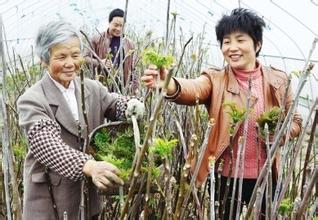
Third, do a good job of cold protection and heat preservation in greenhouse
For Toona sinensis after defoliation, it is necessary to have a temperature of about 25 ℃ for bud germination, and stabilize this temperature for not less than 10 hours a day, which is difficult to meet in general greenhouse. Therefore, an east-west fire path must be installed in the middle of the greenhouse to heat up. In addition, in order to save coal, it is also necessary to put a layer of corn stalks 50 inches thick on the outside of the greenhouse wall. The back slope of the greenhouse is also covered with old grass to reduce heat loss. In addition, the thickness of the grass on the front roof should not be less than 4 meters, and the width of the grass should coincide with the width of 15-20 meters when covering the roof, and a rainproof film should be added to the grass after putting it at night. This can not only play a role in heat preservation, but also prevent rain and snow from soaking the grass and affecting its warmth.
Fourth, the management of budding and changing temperature by high temperature
In order to accelerate the germination of terminal buds, it is necessary to heat up the whole day after planting and keep the room temperature at 25 ℃ ~ 30 ℃. When the top bud was shaded, the temperature was kept at 23 ℃ ~ 25 ℃ in daytime and 12 ℃ ~ 15 ℃ at night, and the temperature difference between day and night was not less than 10 ℃, so as to prevent the stem and leaf from growing too fast, thin, light color, light taste and poor quality.
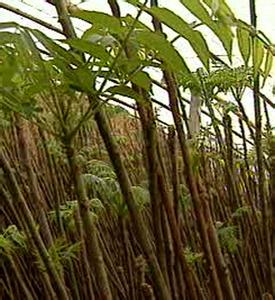
Make full use of greenhouse facilities to change one crop a year to two or three crops
The harvest season of greenhouse Toona sinensis is mainly in winter, that is, from January to mid-March of the following year. At this time, the stems of Toona sinensis were dug out and planted according to 6000m / mu. After survival, the rootstock was cut at 10 to 15m above the ground in time to promote bud germination under the cut, strengthen management after warm weather, and move it into the greenhouse to continue leaf harvesting after defoliation in winter. In general, the leaf picking period is often extended to the end of April, resulting in a net consumption of storage and nutrition in the stalk. If you remove the seedlings from the greenhouse in early March and apply base fertilizer in time, you can also plant a crop of precocious vegetables such as cucumbers, tomatoes, peppers, beans and so on.
The editor will first share the relevant contents of Toona sinensis planting here for you. I hope the above content can be explained to you.
Put the Toona sinensis in bundles in the ditch and fill the soil to bury the roots. Every 3 to 4 ditches, set aside a 45 cm wide walkway for leaf harvesting management. Pour root water once after planting. The planting land generally does not need to apply base fertilizer, because the buds of Toona sinensis germinate and grow, which mainly depends on the storage of nutrients in the stem, and then picked in time after spreading leaves, basically do not use the nutrients in the soil, as long as the soil is moist, the air humidity is about 90%. There is no need for topdressing or foliar spraying during the growth period.

Third, do a good job of cold protection and heat preservation in greenhouse
For Toona sinensis after defoliation, it is necessary to have a temperature of about 25 ℃ for bud germination, and stabilize this temperature for not less than 10 hours a day, which is difficult to meet in general greenhouse. Therefore, an east-west fire path must be installed in the middle of the greenhouse to heat up. In addition, in order to save coal, it is also necessary to put a layer of corn stalks 50 inches thick on the outside of the greenhouse wall. The back slope of the greenhouse is also covered with old grass to reduce heat loss. In addition, the thickness of the grass on the front roof should not be less than 4 meters, and the width of the grass should coincide with the width of 15-20 meters when covering the roof, and a rainproof film should be added to the grass after putting it at night. This can not only play a role in heat preservation, but also prevent rain and snow from soaking the grass and affecting its warmth.
Fourth, the management of budding and changing temperature by high temperature
In order to accelerate the germination of terminal buds, it is necessary to heat up the whole day after planting and keep the room temperature at 25 ℃ ~ 30 ℃. When the top bud was shaded, the temperature was kept at 23 ℃ ~ 25 ℃ in daytime and 12 ℃ ~ 15 ℃ at night, and the temperature difference between day and night was not less than 10 ℃, so as to prevent the stem and leaf from growing too fast, thin, light color, light taste and poor quality.

Make full use of greenhouse facilities to change one crop a year to two or three crops
The harvest season of greenhouse Toona sinensis is mainly in winter, that is, from January to mid-March of the following year. At this time, the stems of Toona sinensis were dug out and planted according to 6000m / mu. After survival, the rootstock was cut at 10 to 15m above the ground in time to promote bud germination under the cut, strengthen management after warm weather, and move it into the greenhouse to continue leaf harvesting after defoliation in winter. In general, the leaf picking period is often extended to the end of April, resulting in a net consumption of storage and nutrition in the stalk. If you remove the seedlings from the greenhouse in early March and apply base fertilizer in time, you can also plant a crop of precocious vegetables such as cucumbers, tomatoes, peppers, beans and so on.
The editor will first share the relevant contents of Toona sinensis planting here for you. I hope the above content can be explained to you.
Related
- Wuhan Hospital Iron Tree Blooming Result Was Instantly Frightened by the Gardener Master
- Which variety of camellia is the most fragrant and best? Which one do you like best?
- What is the small blue coat, the breeding methods and matters needing attention of the succulent plant
- Dormancy time and maintenance management of succulent plants during dormancy
- Minas succulent how to raise, Minas succulent plant pictures
- What are the varieties of winter succulent plants
- How to raise succulent plants in twelve rolls? let's take a look at some experience of breeding twelve rolls.
- Attention should be paid to water control for succulent plants during dormant period (winter and summer)
- Watering experience of twelve rolls of succulent plants
- Techniques for fertilizing succulent plants. An article will let you know how to fertilize succulent plants.



